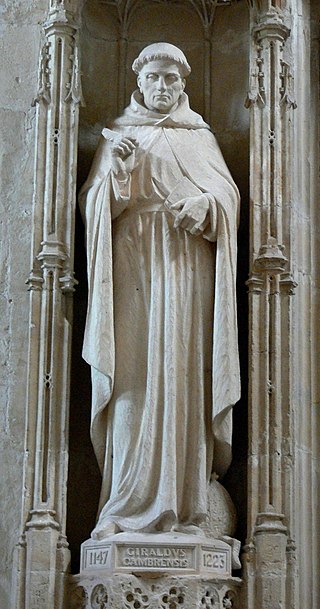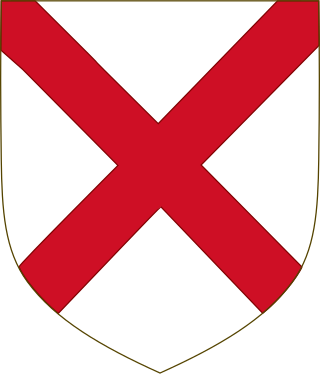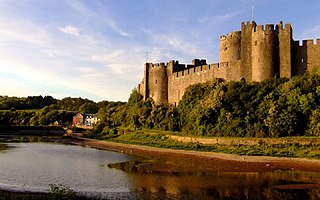Related Research Articles

Gerald of Wales was a Cambro-Norman priest and historian. As a royal clerk to the king and two archbishops, he travelled widely and wrote extensively. He studied and taught in France and visited Rome several times, meeting the Pope. He was nominated for several bishoprics but turned them down in the hope of becoming Bishop of St Davids, but was unsuccessful despite considerable support. His final post was as Archdeacon of Brecon, from which he retired to academic study for the remainder of his life. Much of his writing survives.
Diarmait Mac Murchada, was King of Leinster in Ireland from 1127 to 1171. In 1167, he was deposed by the High King of Ireland, Ruaidrí Ua Conchobair. To recover his kingdom, Mac Murchada solicited help from King Henry II of England. His issue unresolved, he gained the military support of the Richard de Clare, 2nd Earl of Pembroke, thus initiating the Anglo-Norman invasion of Ireland.

Nest ferch Rhys was the daughter of Rhys ap Tewdwr, last King of Deheubarth in Wales, by his wife, Gwladys ferch Rhiwallon ap Cynfyn of Powys. Her family is of the House of Dinefwr. Nest was the wife of Gerald de Windsor, Constable of Pembroke Castle and son of the Constable of Windsor Castle in Berkshire, by whom she was the ancestress of the FitzGerald dynasty.

The FitzGerald dynasty is a Hiberno-Norman noble and aristocratic dynasty, originally of Cambro-Norman and Anglo-Norman origin. They have been peers of Ireland since at least the 13th century, and are described in the Annals of the Four Masters as having become "more Irish than the Irish themselves" or Gaels, due to assimilation with the native Gaelic aristocratic and popular culture. The dynasty has also been referred to as the Geraldines and Ireland's largest landowners. They achieved power through colonisation and the conquest of large swathes of Irish territory by the sons and grandsons of Gerald de Windsor. Gerald de Windsor was the first Castellan of Pembroke Castle in Wales, and became the male progenitor of the FitzMaurice and FitzGerald Dynasty. His father, Baron Walter FitzOther, was the first Constable and Governor of Windsor Castle for William the Conqueror, and was the Lord of 38 manors in England, making the FitzGeralds one of the "service families" on whom the King relied for his survival. Some of its members became the Black Knights, Green Knights and White Knights.

Manorbier Castle is a Norman castle in Manorbier, 5 miles (8.0 km) southwest of Tenby, Wales. It was founded in the late 11th century by the Anglo-Norman de Barry family. The castle was part of a mesne lordship under the control of the medieval Earls of Pembroke.

Robert FitzStephen was a Cambro-Norman soldier, one of the leaders of the Norman invasion of Ireland, for which he was granted extensive lands in Ireland. He was a son of the famous Nest, daughter of Rhys ap Tewdwr, the last king of Deheubarth. His father was Nest's second husband, Stephen, Constable of Cardigan. Following the death of her first husband, Gerald de Windsor, her sons had married her to Stephen, her husband's constable for Cardigan. By Stephen, she had another son, possibly two; the eldest was Robert, and the younger may have been Hywel.

RaymondFitz William Fitz Gerald, nicknamed Le Gros, was a Cambro-Norman commander during the Norman invasion of Ireland. Raymond was among the first of a small band of Norman knights who landed on the South coast of Ireland before being reinforced by a larger force led by Richard de Clare, 2nd Earl of Pembroke. He was active consolidating Norman rule over Ireland before he retired to his estates in Waterford where he died in the late 12th century.

Tighearnán Mór Ua Ruairc, anglicised as Tiernan O'Rourke ruled the kingdom of Breifne as the 19th king in its Ua Ruairc dynasty, a branch of the Uí Briúin. As one of the provincial kings in Ireland in the twelfth century, he constantly expanded his kingdom through shifting alliances, of which the most long-standing was with Toirdelbach Ua Conchobair King of Connacht and High King of Ireland, and subsequently his son and successor Ruaidhrí Ua Conchobair. He is known for his role in the expulsion of Diarmait Mac Murchada, King of Leinster, from Ireland in 1166. Mac Murchada's subsequent recruitment of Marcher Lords to assist him in the recovery of his Kingdom of Leinster ultimately led to the Norman invasion of Ireland.

Gerald FitzMaurice FitzGerald (1335–1398), also known by the Irish Gaelic Gearóid Iarla, was the 3rd Earl of Desmond, in southwestern Ireland, under the first creation of that title, and a member of the Anglo-Norman dynasty of the FitzGerald, or Geraldines. He was the son of Maurice FitzGerald, 1st Earl of Desmond, by his third wife Aveline (Eleanor), daughter of Nicholas FitzMaurice, 3rd Lord of Kerry. He was half-brother to Maurice FitzGerald, 2nd Earl of Desmond.

The Anglo-Norman invasion of Ireland took place during the late 12th century, when Anglo-Normans gradually conquered and acquired large swathes of land in Ireland over which the monarchs of England then claimed sovereignty. The Anglo-Normans claimed the invasion was sanctioned by the papal bull Laudabiliter. At the time, Gaelic Ireland was made up of several kingdoms, with a High King claiming lordship over most of the other kings. The Anglo-Norman invasion was a watershed in Ireland's history, marking the beginning of more than 800 years of British rule in Ireland.

The de Barry family is a noble Cambro-Norman family which held extensive land holdings in Wales and Ireland. The founder of the de Barry family was a Norman knight, Odo, who assisted in the Norman Conquest of England and south-east Wales during the 11th century. As a reward for his military services, Odo was granted estates in Pembrokeshire and around Barry, Wales, including Barry Island just off the coast.
Odo was count of Troyes and of Meaux from 1047 to 1066, then count of Aumale from 1069 to 1115. He was later also known as the count of Champagne and as Eudes II of Troyes.

Gerald de Windsor, aliasGerald FitzWalter, was an Cymro-Norman lord who was the first Castellan of Pembroke Castle in Pembrokeshire. Son of the first Norman-French Constable of Windsor Castle, and married to a Welsh Princess daughter of the King of Deheubarth, he was in charge of the Norman forces in south-west Wales. He was also steward and governor for the Norman magnate Arnulf de Montgomery. His descendants were the FitzGerald dynasty, as well as the FitzMaurice, De Barry, and Keating dynasties of Ireland, who were elevated to the Peerage of Ireland in the 14th century. He was also the ancestor of the prominent Carew family, of Moulsford in Berkshire, the owners of Carew Castle in Pembrokeshire and of Mohuns Ottery in Devon.

Maurice FitzGerald, was Lord of Maynooth, Naas, and Llanstephan. He was a medieval Anglo-Norman baron and a major figure in the Norman Invasion of Ireland.
The Synod of Cashel of 1172, also known as the Second Synod of Cashel, was assembled at Cashel at the request of Henry II of England shortly after his arrival in Ireland in October 1171. The synod sought to regulate some affairs of the church in Ireland and to condemn some abuses, bringing the church more into alignment with the Roman Rite. As such it can be seen as a continuation and part of the Irish church reform of the twelfth century, with the first synod of Cashel, the Synod of Rathbreasail and the Synod of Kells, slowly embracing the Gregorian Reforms. The extent to which the synod set the direction for the relationship between the English and the Irish church has been the subject of scholarly debate. Stephen J. McCormick described the synod as one of the most important events of this period of Irish history.

Gerald FitzMaurice, jure uxoris 1st Lord of Offaly was a Cambro-Norman nobleman who took part with his father, Maurice FitzGerald, Lord of Llanstephan, in the Norman Invasion of Ireland (1169–71). Together with his five brothers and one sister Nesta they founded the notable FitzGerald/FitzMaurice dynasty which was to play an important role in Irish history.
Meiler FitzHenry was a Cambro-Norman nobleman and Lord Chief Justice of Ireland during the Lordship of Ireland.

The siege of Wexford took place in early May 1169 and was the first major clash of the Anglo-Norman invasion of Ireland. The town was besieged by a combined force of Normans under Robert Fitz-Stephen and soldiers loyal to Diarmait mac Murchadha. After being ousted as King of Leinster, Diarmait had recruited the Normans to help him regain control of Leinster and the semi-independent Norse-Gaelic seaport of Wexford. Although the attackers did not breach the town's walls, Wexford surrendered after almost two days and came under Norman control.
Philip de Barry, was a Cambro-Norman warrior from Manorbier in Pembrokeshire who participated in the colonisation of Kingdom of Desmond following the Norman invasion of Ireland. He was the founder of the Barry or De Barry family in County Cork, and common ancestor of the barons Barry and earls of Barrymore.
Milo de Cogan was an Anglo-Norman knight from Glamorgan who played a significant role in the Norman conquest of Ireland under Richard de Clare, 2nd Earl of Pembroke; a man better known to Irish history as Strongbow.
References
- ↑ Expugnatio Hibernica by Giraldus Cambrensis; A B Scott & F X Martin, editors; Dublin 1978 edition; historical introduction page xxi
- ↑ Expugnatio Hibernica (extract) by Gerald of Wales (1189) - reproduced by permission of The Medieval Source Book on Britannia Internet Magazine.
![]() This article incorporates text from a publication now in the public domain : "Barry, Robert de". Dictionary of National Biography . London: Smith, Elder & Co. 1885–1900.
This article incorporates text from a publication now in the public domain : "Barry, Robert de". Dictionary of National Biography . London: Smith, Elder & Co. 1885–1900.